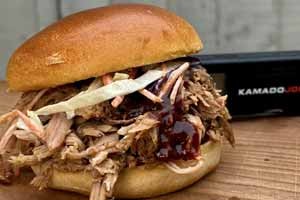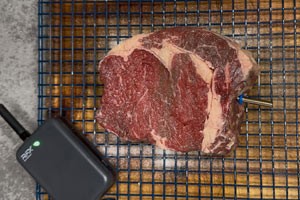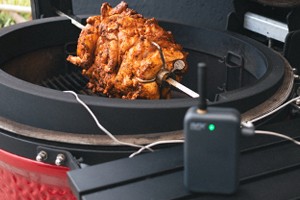Easy, tender BBQ pulled pork, loaded into buns with coleslaw and BBQ sauce.
Traditional Pork Pies
This traditional pork pie recipe by Jane Sarchet from The Hedgecombers goes all out.
It features homemade hot water crust pastry and a flavoursome jelly - the pillars of
a classic pork pie.
Traditional Pork Pie Recipe
For the hot water crust pastry
- 350 g plain flour sieved
- 140 ml water
- 110 g lard
- 1 tsp salt
- 1 egg beaten
For the pork pie filling
- 500 g pork shoulder diced
- 1 tsp dried sage
- 1 tsp salt
- 1 tsp pepper
For the pork pie jelly
- 1 pig trotter
- 1 litre water
- 1 onion halved
- 1 tsp salt
- 1 tsp white pepper
How do you know when pork pies are cooked?
Pork pies need to reach an internal temperature of at least 71 °C for the meat to be safe to consume. They'll likely go over this temperature, as you'll also want to cook them until the pastry is nice and golden. But it's always good to have a quick check with your Thermapen so you can be confident they're safely cooked.
How long does a pork pie last in the fridge?
Homemade pork pies will last up to five days in the fridge.
Can you freeze pork pies?
Pork pies keep well in the freezer for up to five months. Make sure they're fully cooled before putting them into the freezer. Wrap them in a layer of baking paper and a layer of tin foil before placing in a freezer bag for optimum results.
To make the hot water crust pastry
- Preheat the oven to 180.
- As the oven is heating, pop a large, ovenproof mixing bowl with the flour and salt in for a few minutes, until it reaches 22 °C on your Thermapen.
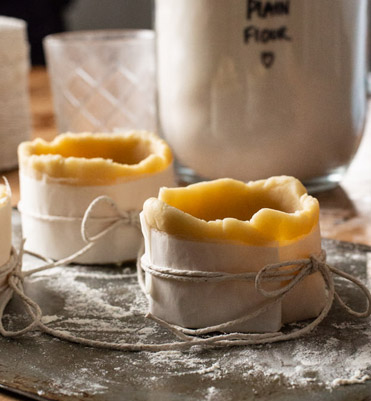
- Gently bring the water and lard to a boil together in a saucepan. When the lard has melted, pour the mixture into the warm mixing bowl and stir the ingredients together until well combined.
- When the dough has come together, and has cooled enough to handle, knead it for a few minutes. It is important that the dough stays warm so as to be pliable enough to mould into the pie shells, so try not to let it cool too much.
- Place the dough on a floured board and cut off 1/3. Replace this into the mixing bowl with a tea towel over the top to keep the heat in. This off-cut will be ‘lid’ to your pie or pies.
- With the remaining two thirds of the dough you are going to make the ‘body’ of your pie. If you are making three medium sized pork pies like I have in the pictures, divide the pastry into three. Work on one portion of dough at a time, keeping the rest in the warm bowl. However if you are making one large pie, keep the dough whole.
To make the pork pie jelly
- I use pigs trotters for my savoury pork pie jelly, but you can also use gelatin sheets if you prefer.
- Place the cleaned trotter into the slow cooker along with the water, onion, salt and white pepper. Cook on high for 4 hours, or on low overnight.
- I like to split the trotter halfway through the cooking time to allow more of the gelatin to be released into the cooking water.
- Once cooked, drain well, keeping all of that wonderful stock. The debris can be disposed of and any extra stock can be frozen in ice cube trays and used in sups, stews and casseroles to enrich and boost nutrition.
To make the pie
- Dust a Pork Pie Dolly or mould with flour, then mould the warm pastry into an even layer with your hands. Work quickly as the warm dough is much easier to shape. Leave a small overhang for sealing the lid on, and try to get a smooth shell with no gaps or splits.
- Repeat with the remaining dough. If you are making a freestanding pork pie like in the pictures, carefully removing the pastry from the dolly, and tying a strip of folded baking paper around the ‘belly’ of the pie will help hold it up.
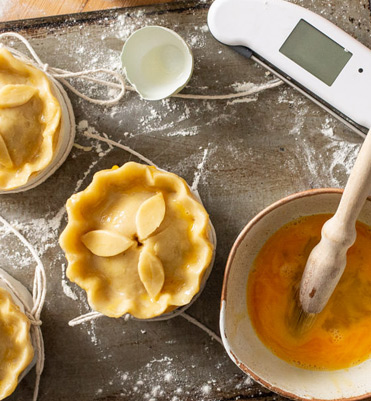
- Mix together the pork, sage, salt & pepper in a bowl. Carefully fill each pie shell with 1/3 of the mixture, pressing down as necessary and leaving the meat in a dome shape in the middle.Mix together the pork, sage, salt & pepper in a bowl. Carefully fill each pie shell with 1/3 of the mixture, pressing down as necessary and leaving the meat in a dome shape in the middle.
- Divide the reserved ‘lid’ pastry into as many pies as you are making. Roll each piece out into a circle.
- Brush the overhanging area with the beaten egg, and place the lids on and seal well. You can simply press the pastry together firmly, or crimp it as in the pictures.
- Using the tip of a sharp knife, pierce a hole in the centre of the pastry lid. This is where your funnel tip needs to fit once the pie is cooked, so twist the knife tip until the hole is large enough to fit your funnel tip.
Baking the pies
- Brush the pies generously all over with egg wash.
- Bake the pies in the preheated oven for 20 minutes, then reduce the oven to 160, and continue cooking for a further 50 minutes.
- Midway through the cooking time remove the baking paper sleeves if using, and brush again all over with egg wash. Return to the oven to finish cooking. Check the internal temperature has reached 71 °C before removing from the oven.
- Set the cooked pies to cool on a wire cooling rack. When at room temperature, move to the fridge to let cool fully.
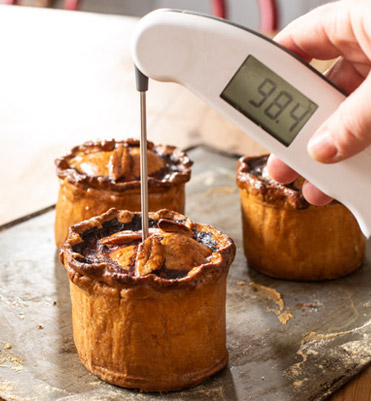
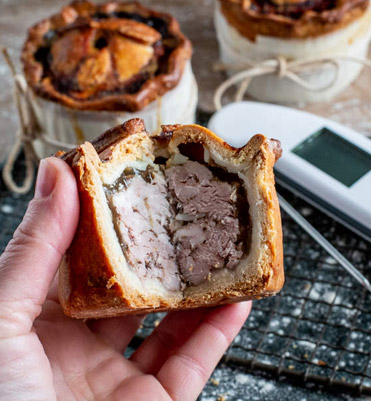
Filling the pies with jellied stock
- When your pies are completely cold, gently insert the tip of the funnel into the hole in the lid.
- Pour the hot stock into the hole very slowly. You don’t want it overflowing, so allow it time to soak down into all the gaps and crevices.
- When the pies are full of stock, return them to the fridge to fully cool again. Be sure to leave them overnight for the stock to fully firm up.
- When ready to eat, cut the pie into wedges to see your work of art, and enjoy!
"My Thermapen is never far away, whether I'm making jams with foraged hedgerow fruits, or ensuring that meats cooked on an open fire are safe and perfectly cooked."






